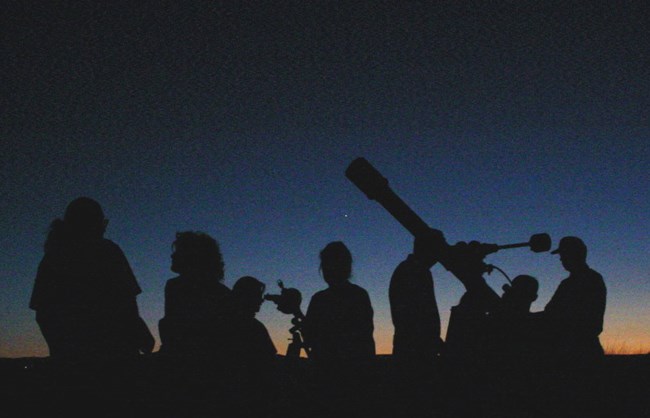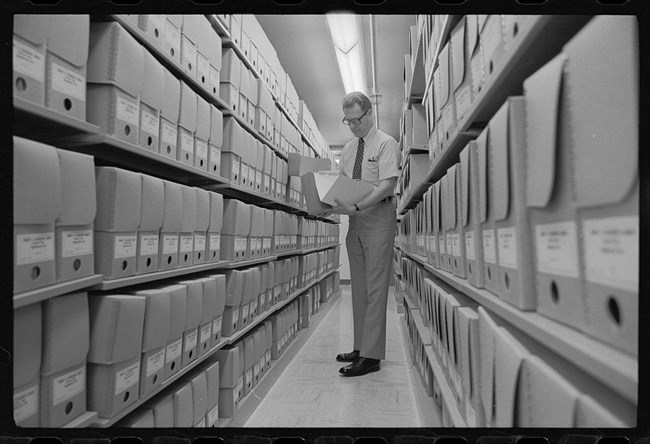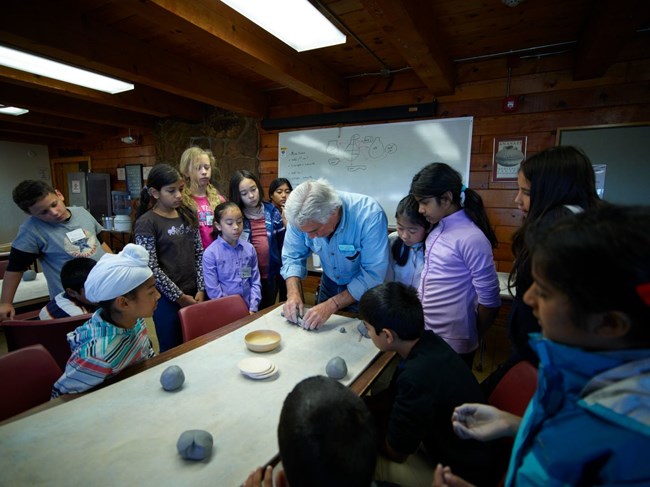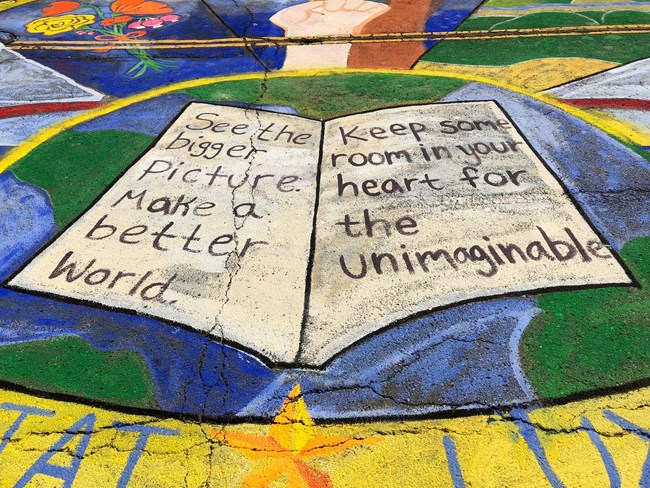Last updated: February 19, 2025
Article
Pathways Through American History: Everyone Has a History

Public domain.
Marker 1 of 4: What does a historical figure look like?
Go look in the mirror. What do you see?
Think about some of the stories you know from United States history. Who do you see reflected there?
History doesn’t just happen. People in the past made choices (and sometimes mistakes) based on the information and values they had at the time. Things would be different in the present if they made different choices.
What can you gain from history by learning about their struggles and triumphs? What values inform your decision-making?

Courtesy Library of Congress.
Marker 2 of 4: How do historians use documents to reconstruct what we know about the past?
Historians are like detectives who investigate what happened in the past based on clues that people left behind. These clues are called primary sources, because they were created firsthand by people in the past. Historians often rely on written primary source documents like letters, journals, maps, and newspapers.
Language plays a key role in how we document the past and communicate. The terms and names we use shape our reality and influence how we understand the world, because they reflect how we choose to remember the past.
Imagine you are a historian reconstructing what happened in the past. What does history need from you to remain fair, accurate, and credible?
Reconstructing the Past
-
 ArticleSearching for Servants
ArticleSearching for ServantsIf historians want to learn about people who didn't keep a journal or leave written records, they may use documents like census records.
-
 Learning ResourceLanguage of Slavery
Learning ResourceLanguage of SlaveryThe National Park Service & its partners use terms that reflect the Underground Railroad's goal of liberty & the agency of its participants.
-
 Learning ResourceDenali or Mount McKinley?
Learning ResourceDenali or Mount McKinley?In 2015, the name North America's highest peak changed from “Mount McKinley” to “Denali,” bringing over 100 years of debate to an end.
More to Explore
The resources below focus on the primary documents that historians use to learn about the past. Consider how the choices that historians make affect what we know about the past and the way we remember it.
Homesteading Land Entry Case Files Online Activity
Homesteaders did lots of paperwork to obtain pieces of land. Historians use these detailed land records to learn about the past.
How to Read a Photo
When analyzing historic photographs, observations, deductions, & inferences can uncover complex stories hidden in plain sight.
Restoration of Indigenous Place Names
Learning about traditional place names can reveal deeper cultural relationships & impart more meaningful experiences when visiting.
Proposals to Change the Name
Learn about the proposals and processes associated with efforts to rename Devils Tower National Monument.

Photo by Carol Highsmith. Courtesy Library of Congress.
Marker 3 of 4: How can including different kinds of sources enrich our understanding of the past?
Lots of what we know about the past comes from the written record, but there are also things that have been left out of historical documents. Other experiences cannot be captured in writing. Discover some of the ways we can learn about the past besides written sources.
Think about all the objects and materials you've touched so far today. In 100 years, what will remain? What will future generations know about you from what you leave behind?
Excavating the Past
-
 Subject SiteOral History
Subject SiteOral HistoryPeople's stories are among the most valuable resources that the National Park Service preserves and protects for future generations.
-
 Subject SiteArcheology
Subject SiteArcheologyMany people think the past is behind us. Archeologists know it's just below the surface.
-
 Education ResourceNew Philadelphia
Education ResourceNew PhiladelphiaArcheologists and historians pieced together documents, recollections of descendants, and artifacts to tell the story of a multiracial town.
More to Explore
The resources below introduce two more ways to consider how historians and archeologists know what they know. Think about what we can gain from incorporating these ways of knowing and what we would lose without them.
Traditional Ecological Knowledge
TEK consists of practices & beliefs that Indigenous people acquired over millennia through direct contact with specific ecosystems.
Your Turn! The Past, Present, and Future
Art can teach us about people's everyday lives. Archeologists study murals from the past to understand the period when they were painted.

Photo by Fabrice Florin, CC BY-SA 2.0.
Marker 4 of 4: How do we use stories to tell others about who we are? How do they affect how we think about ourselves and others?
Storytelling--including documenting history--has the power to speak to the perspectives and experiences of people whose lives may be similar or unlike our own. Throughout American history, sharing our perspectives with each other has influenced people to question cultural prejudices, stand up against injustice, and build bridges across our differences.
Consider this quote by poet and advocate Kay Ulanday Barrett: "We have to harvest and cultivate our own stories, not just to feel valid, but to feel rejoiced." Have you ever felt rejoiced? Who or what made you feel that way?
Telling Stories
-
 PodcastBallot Blocked: Mary Church Terrell
PodcastBallot Blocked: Mary Church TerrellTerrell's fluency in multiple languages enabled her to advance racial justice & gender equality on both sides of the Atlantic.
-
 PersonOlivia Robello Breitha
PersonOlivia Robello BreithaWriting a book enabled Breitha to raise awareness about how the world excluded & dehumanized her because she had Hansen's disease.
-
 ArticleZora Neale Hurston & Cudjo's Own Story
ArticleZora Neale Hurston & Cudjo's Own StoryHurston chronicled the lives of people who were captured from Africa & enslaved in the US because their stories were usually not told.
More to Explore
The resources below provide more examples of how speaking your own truth provides a powerful form of testimony and helps others broaden their own perspectives.
Curiosity Kit: Ida B. Wells
As a journalist & activist, Wells's scathing exposés of lynchings brought national attention to violence committed against Black people.
Nellie Bly
Bly was a pioneer in investigative journalism. Her reporting introduced readers to international travel & the horrors of insane asylums.
Curiosity Kit: Malcolm X
From the racial violence of his childhood to predicting his own death, Malcolm X's autobiography provides insight into his life & legacy.
Interpreting an Absent History
Few resources remain from Rohwer Relocation Center. Actor George Takei's testimony helps sustain the absent history that the site embodies.
Keep Up the Pace
Now that you know how people told their stories in the past and how historians reconstruct them, how would you tell yours? Check out the Primarily Me Challenge to learn how you can use sources to document your story.
Get Off the Beaten Path
The content for this article was researched and written by Jade Ryerson, an intern with the Cultural Resources Office of Interpretation and Education.
Tags
- pathways through american history
- african american history
- american latino heritage
- african american heritage
- asian american and pacific islander heritage
- asian american and pacific islander history
- disability history
- european american history
- indigenous history
- women's history
- historian
- archeology
- archaeology
- storytelling
- language
- naming
- primary source
- legacy
- cultural heritage
- oral history
- lgb

